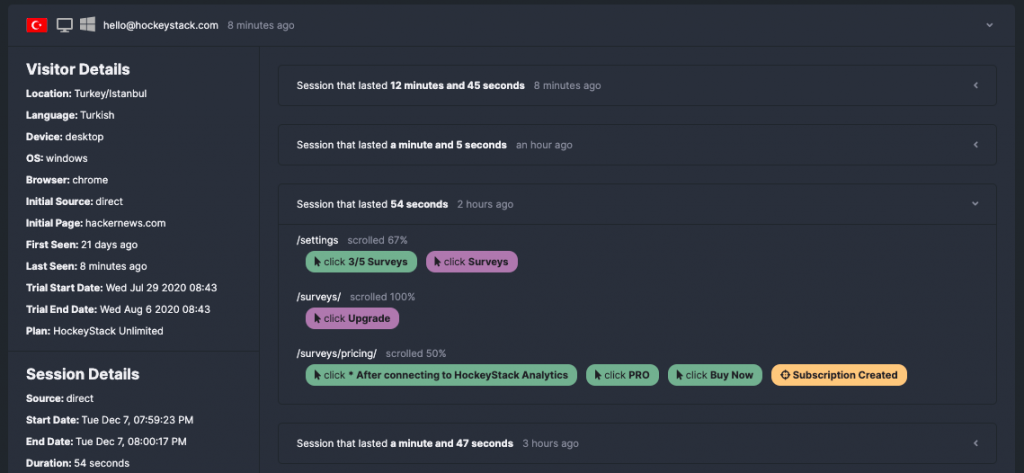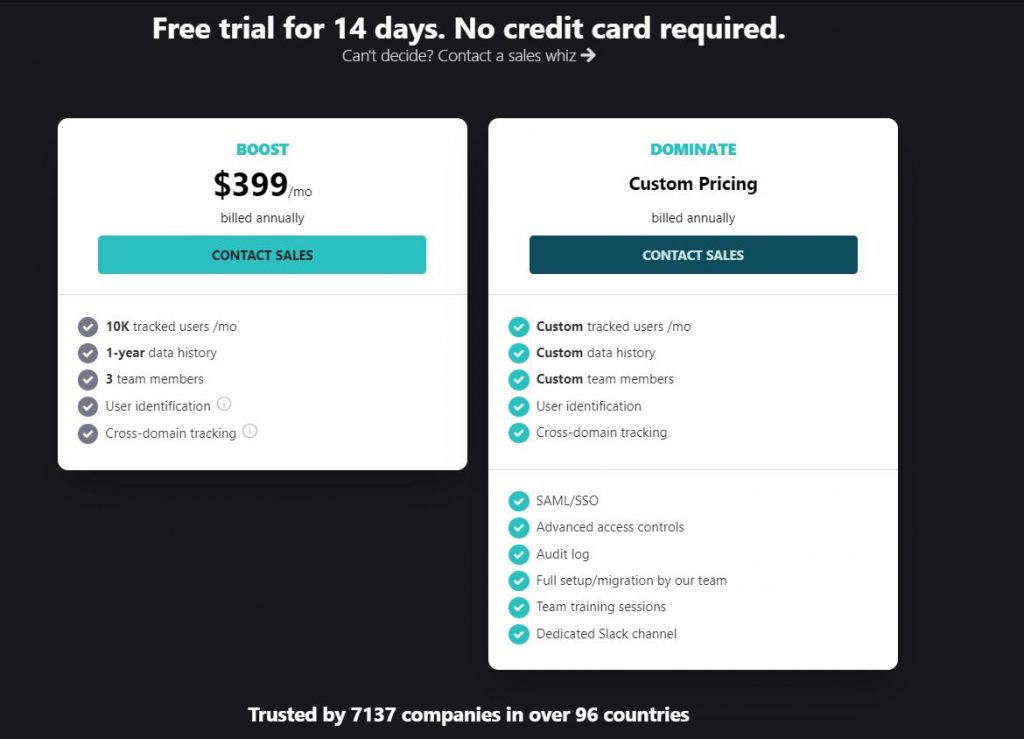Top 7 Email Marketing KPIs For 2022
Email marketing is one of the most effective and profitable marketing techniques for SaaS businesses. Ranging from welcome emails to winback emails, email marketing can help you decrease churn and increase your retention rate. Therefore, tracking email marketing and collecting data about it is crucial for your business’s growth and establishing a successful onboarding.
What Are Email Marketing KPIs?
Email marketing KPIs, or key performance indicators, are the performance metrics of your email marketing efforts. In other words, KPIs are set to track and collect data about the effectiveness of your email marketing strategy.
It is pretty easy to confuse email marketing KPIs and email marketing metrics since they both deal with the performance of a specific variable. However, while the metrics are measurements of overall business growth and strength, KPIs are measures of progress towards a specific goal.
Let’s illustrate this further with the help of an example. Say your your business goal is to attract new subscribers. In this case, you need to create KPI that focuses on metrics that track people that have unsubscribed, new subscribers, click rates, etc. Just looking at a simple metric cannot be a KPI. KPI should include both the goal and path.
Let’s take a look at some of these KPIs for email marketing.
1. CTR
What Is CTR?
CTR, or clickthrough rate, can be defined as the percentage of recipients who clicked on one or more links in the email.
For this KPI, the desired action is for the reader to actively engage with the email and click on the links provided.
Why Is CTR Important?
Sometimes, even though the open rate is high, there might be a low CTR, which shows that your subscribers are not taking desirable actions. Therefore, CTR gives you insights about how many of your subscribers are active subscribers that engage with your emails.
High CTR is a good indicator that your links are relevant, placed in good positions throughout the emails, and that your subscribers are eager to learn more about what you can offer. On the other hand, low CTR shows you that most of your subscribers are passive subscribers that are not engaging with your product/service. This may also indicate a high churn rate.

How to Improve CTR
Most of the time, low CTR results from disorganized and distracting emails. If your links are scattered around without even indicating they are links, it is not your subscribers’ responsibility to find those links and click on them.
It is also important to think about the overall design of your emails. Make your emails as concise as possible so your subscribers can understand your main point and do what you want them to do.
Remember that clicking on the “unsubscribe” button might also be counted as a click (thus can be part of CTR). Therefore, be careful about which clicks you are tracking.
2. Unsubscribe Rate
What Is Unsubscribe Rate?
The unsubscribe rate is the percentage of subscribers that quit the email subscription after opening an email.
This KPI is one of the most vital ones because it gives you an idea of where and why you lack strength in your email marketing. Also, this could indicate what your subscribers like in your emails and what they don’t.

Why Is Unsubscribe Rate Important?
The unsubscribe rate is helpful to calculate your overall growth and gives you insights into your subscriber’s list. It is especially helpful if your open rates and CTR decrease because the unsubscribe rate is directly related to the churn rate.
How to Improve Unsubscribe Rate
One of the most effective ways to improve the unsubscribe rate is segmentation. Since your customers will be in different stages of the customer journey, it’s important to send them emails that are relevant to them and prompt them to take certain actions.
You may lose subscribers if you send out mass emails to irrelevant audiences such as sending a template-based email about your latest features to a customer who has repeatedly stated how many problems they have with your customer support . Using a tool like HockeyStack, you can analyze everything from the CTR to the number of users that move from one blog post to another thanks to internal links.

3. Spam Complaints
What Are Spam Complaints?
Spam complaints are the reports made by your subscribers against the emails they don’t want in their inbox. These are unsettling and demoralizing since they indicate that your emails are unwanted.
Why Are Spam Complaints Important?
Spam complaints show you that your emails are not reaching the right subscribers. This is a very important KPI and shouldn’t be ignored at all as it can help with everything from messaging to personalization, hence improving the effectiveness of email marketing strategy. It can also show you that the design and organization of your emails are similar to spam emails, which is one of the most undesirable things for email marketers.
How to Reduce Spam Complaints
Even though spam complaints are negative actions, it is pretty normal to have some since you cannot control every aspect of engagement between your emails and subscribers. However, you need to keep spam complaints at a minimum since they can harm your credibility and reputation.
Several ways to improve spam complaints are:
- Using double-opt can refine your subscribers list and help you to send emails only to people that really want them.
- Unsubscribing is a better choice than spam complaints since the former doesn’t really affect your reputation. Therefore, always try to make the unsubscribe button visible and accessible to ensure that users that don’t want to receive your emails are not forced to open and complain against them.
- Ensure that the sender’s email and the subject line are clear and understandable. Most of the time, spam complaints are the result of misunderstandings. Therefore, try to be as specific and clear as possible about the sender and what the email is about.
4. Email Delivery Rate
What Is the Email Delivery Rate?
Email delivery rate is the percentage of a given email delivered to your subscribers. It is the first KPI to check for successful email marketing because most KPIs depend on the email delivery rate.
Why Is Email Delivery Rate Important?
Email delivery rate shows you how many of your subscribers see your emails in the box. It gives you a clear idea of whether your emails are getting lost in the way of reaching the target.
Other KPIs depend on email delivery rate because without delivery, you cannot track CTR, unsubscribe rate, open rate, spam complaints, etc.
How to Improve Email Delivery Rate?
Just because you’re sending emails does not necessarily mean they are delivered. Therefore, assuming a 100% delivery rate is just tricking yourself. However, keeping the email delivery rate as high as possible should be one of your main goals.
One of the leading causes of undeliverability is that your subscriber’s list might be old and unrefined. If your list is old, you might be sending emails to invalid email addresses, which decreases the email delivery rate. You can use email verification tools to verify email addresses and reduce your bounce rate.
You should also avoid spam traps, which block your emails to reach your subscribers’ inboxes. Try to use non-spammy subject lines and sender addresses to make your emails accessible.
5. Conversion Rate
What Is Conversion Rate?
Conversion rate is the percentage of subscribers who complete the desired actions through links. For example, if an email wants you to complete a form, clicking the form link within the email and filling out the form will count as a conversion.
Why Is the Conversion Rate Important?
It might not exactly be profitable for you if a recipient simply opens and reads through your email. This can help you reach your audience, but your main goal should be to propel your subscribers to take the desired actions. Therefore, the conversion rate is a great KPI to show if your subscribers behave the way you want them to.
It also shows you whether your emails are engaging and effective enough to catch your subscribers’ attention and carry the necessary steps to complete the desired actions, such as registering for a demo, downloading a manual, or filling out a form.
How to the Improve Conversion Rate
Since the conversion rate is an indicator of whether you are generating prospects and leads or not, it is important to keep the conversion rate high. To do that, you can try to:
- Customize and personalize your emails according to your subscribers’ needs and preferences.
- Keep your emails precise and concise to avoid disinterest and disengagement.
- Make your CTA, call to action, visible and attractive so that your subscribers don’t lose and miss it.
6. Monthly List Growth Rate
What Is Monthly List Growth Rate?
The monthly list growth rate is the monthly measure of your email list growth. It tracks how much your subscriber’s list grows or shrinks in a month and informs you about the success of your email marketing campaigns.
Why Is the Monthly List Growth Rate Important?
The monthly growth rate helps you keep your subscribers list refined and segmented. By tracking it, you can understand where and why you are attracting new subscribers, and similarly, where and why you are losing them. This helps you to understand your email marketing campaigns’ strengths and weaknesses.
How to Improve Monthly List Growth Rate?
When you think about the monthly list growth rate, the first thing that comes into mind is the ways to attract new subscribers. One of the effective ways to expand your subscriber’s list is to make shareable content to reach possible new customers. However, it is also important to create re-engagement emails to keep your current subscribers happy and satisfied. Make sure that you send emails according to your subscribers’ needs and preferences, and your emails generate value for them. In this way, you can eliminate unwanted subscriber losses.
7. Share Rate
What Is Share Rate?
Share rate is the percentage of subscribers who clicked on the “share” button to post the email content to social media or clicked on the “forward” button to share it with another recipient.
Why Is Share Rate Important?
Share rate is a related KPI with unsubscribe rate and monthly email list growth rate since their main aim is to keep your current subscribers engaged and attract new customers. By making shareable and engaging emails, you can reach possible new customers interested in your content. Therefore, you can attract new subscribers (and possibly new customers) without spending any money on additional marketing strategies.
How to Improve Share Rate?
Share rate depends mainly on the content of your email and how you display it. Therefore, you need to consider different aspects of your email:
- Visuals are great ways to make an email engaging and shareable. By adding photos, infographics, or any other type of visuals to your emails, you can contribute to the share rate. However, make sure that you don’t go overboard with visuals since they can be distracting, hindering your main aim.
- Information presented as facts in small bites is attractive to the eye and mind. Since they intrigue the reader, you increase the chance of the email being shared online or forwarded to a friend or acquaintance.

Using HockeyStack to Track Email Marketing KPIs
There is a lot of aspects to consider while building a power email marketing strategy, such as deciding on your business goals and KPIs to track. Fortunately, HockeyStack can help you to create the best marketing strategy for your needs and preferences.
HockeyStack is an end-to-end analytics and attribution tool for SaaS companies. It unifies marketing, revenue, sales, and product data into one dashboard with no code so that you can understand what really drives revenue at your SaaS. It’s completely no code, and it doesn’t require any setup.
HockeyStack’s Features
Step-by-step user journey
HockeyStack allows you to access every single users’ whole journey without spending your valuable time on video replays. You can filter your users with every single session and user property, including LTV, job title, goals, segments, clicks, etc.
Thanks to its attribution features, HockeyStack will also help you identify if your users read an email before filling out your pricing form.

Custom dashboards
You can build custom dashboards using every revenue, product, sales, and marketing data you have using HockeyStack. We also have a template gallery inside our dashboard to inspire you.

Funnels and goals
An analytics tool cannot be complete without funnels and goals. What makes HockeyStack special is you don’t need any coding knowledge to set up your funnels & goals. Everything is tracked automatically, without any additional effort on your part, making the entire process as hassle-free as possible.

Surveys
HockeyStack is really the complete package for your SaaS. You can create visually appealing surveys to get honest feedback from your customers, including churn, NPS, and pricing surveys.
We also have a wide variety of questions types that you can choose from, and surveys are completely free for everyone!

Revenue analytics
By connecting your Paddle/Stripe account with one click, you can use HockeyStack as a revenue analytics tool without any additional effort! With its wide range of features, HockeyStack can help you set up every single revenue analytics dashboard you need and gain a better understand of what drives revenue.

HockeyStack Pricing
HockeyStack has two plans, both of which have a 14-day trial with a 30-day refund guarantee.
You can check out the pricing page here.

HockeyStack Integrations
- Paddle
- Stripe
- Hubspot
- Mailchimp
- Crisp
- Pipedrive
- Salesforce
- Zapier (coming soon)
Conclusion
KPIs are essential indicators of progress on your specific business goals. Whether they focus on the number of people unsubscribing or click-throughs, all KPIs can be used together to see the big picture of your email marketing efforts. Therefore, keeping track of the right KPIs is crucial to track your email marketing performance.
FAQ
KPIs are the indicators of progress towards a specific goal. On the other hand, email marketing metrics are variables that help you to define and track your KPI. By combining different metrics and collecting data about them, you can check your KPIs.
By refining and keeping your subscribers list up-to-date, you can easily get rid of receivers who have invalid email addresses, which affect your email delivery rate.
Yes, a small percentage of spam complaints is normal since you cannot manage all variables in an equation. However, you should always aim to decrease your spam complaints by considering different aspects of email marketing.



